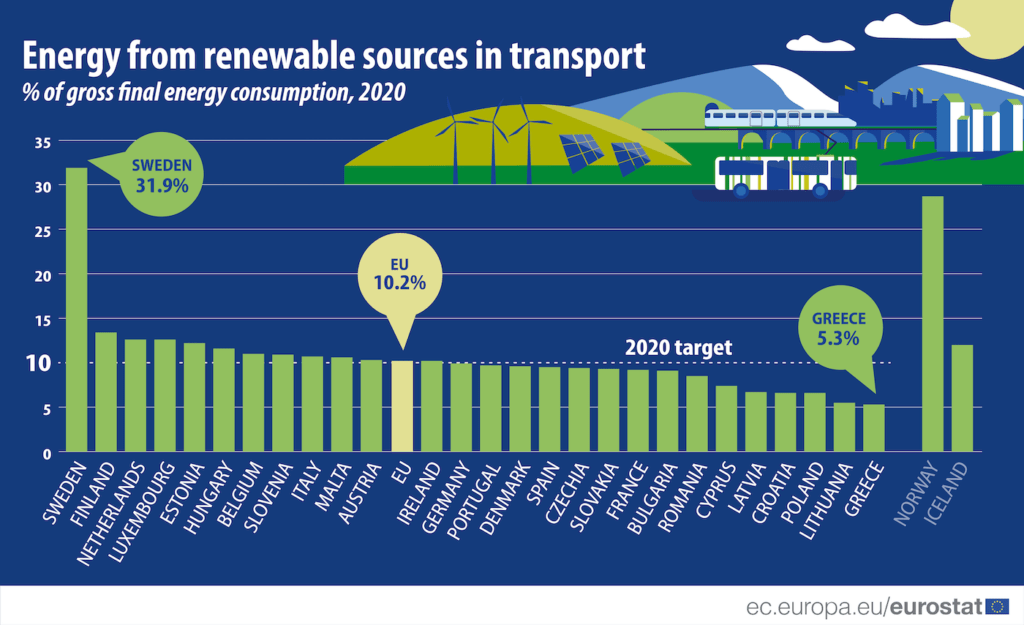
EU data confirms key contribution of biomethane to clean mobility
Date
Sections

The statistical office of the European Union (Eurostat) announced this week that the EU has met the target of 10% deployment of renewable energy in transport by 2020. The target was set to reduce greenhouse gas (GHG) emissions in the transport sector by promoting the use of renewable energy. The share of green energy in the EU mobility sector includes biomethane, liquid biofuels and renewable electricity. These renewable alternatives should benefit from relevant legislative support to make sure we continue reaching our GHG emissions reductions goals in the transport sector.
The EU transport sector relies heavily on fossil fuels and is responsible for one quarter of Europe’s GHG emissions, a share that keeps growing. In addition, the sector is a significant source of air pollution. Hence, the replacement of fossil fuels by renewable alternatives in transport is right now one of EU’s top priorities.
Eurostat data show that the average share of energy from renewables in transport increased from 1.6% in 2004 to 10.2% in 2020, slightly above the target level. This share includes renewable electricity, but also biomethane and liquid biofuels. It would be logical to think that all these solutions receive equal support to make sure that the share of renewable energy in transport continues growing.
Part of this support will come from the development of relevant legislation. However the focus on electricity only and the related tail pipe approach is leading to a stop on alternative fuels with equal or sometimes even better GHG footprint. Whilst we need to decarbonize as quickly as we can, we do not have the luxury to focus on only one fuel. All alternative fuels are needed and should be supported in relation to their total GHG footprint. Hence, proposed stops on production of combustion engine (ICE) cars from 2035 seems at first sight sensible. The focus should not be on the engine, but on the fuel used. Besides, ICE engines are more affordable for EU citizens.
The share of biomethane in transport is significantly higher than the share of green electricity. Data from NGVA Europe disclosed also this week shows that more than a quarter of the gas used in road transport today is renewable and 3,810 CNG stations delivered biomethane to European consumers in December 2020[1].
The role of biomethane in reducing emissions in the transport sector deserves more attention. Many studies confirm the incredibly high performance of this alternative to reduce emissions according to the lifecycle approach (LCA)[1]. The LCA approach considers all emissions released across the whole lifespan of the vehicles. The GHG emissions balance when using this green fuel can even be negative, meaning that the vehicle is not increasing the emissions but, instead, reducing them. However, the EU standard to measure CO2 emissions in the mobility sector proposed by EU legislation is focusing only on 1 part of the total emissions (tailpipe emissions) which gives a distorted picture of the emissions related to transport.
If we go back to Eurostat data, Sweden was the clear leader in the use of renewables in transport with a share of 31.9%. This leadership is explained, according to the EU statistical office, by the high use of compliant biofuels, including biomethane. The Swedish state provides investment support for sustainable biomethane production and refueling infrastructure. The government provides also end user incentives to stimulate the purchase of vehicles running on sustainable gas and has set out strict environmental zones in cities, allowing only low emission vehicles. They also apply long-term tax exemptions on biomethane, ensuring that vehicles are refueled with renewable and sustainable biomethane. This approach has resulted in a world leading biomethane share of 95%.
The data disclosed by Eurostat this week prove that there is not one single solution towards net-zero in transport and, consequently, support to all readily available solutions and technologies is crucial. This support should come in the form of a clear, coherent and technology-neutral legislative framework driving investments towards the large-scale development of all renewable alternatives contributing to clean mobility.
[1] https://www.ngva.eu/medias/2510-biocng-in-2020-new-data-proves-rapid-growth-of-biomethane-in-transport/
[1] https://www.europeanbiogas.eu/acknowledging-the-full-potential-of-biomethane-as-transport-fuel/
